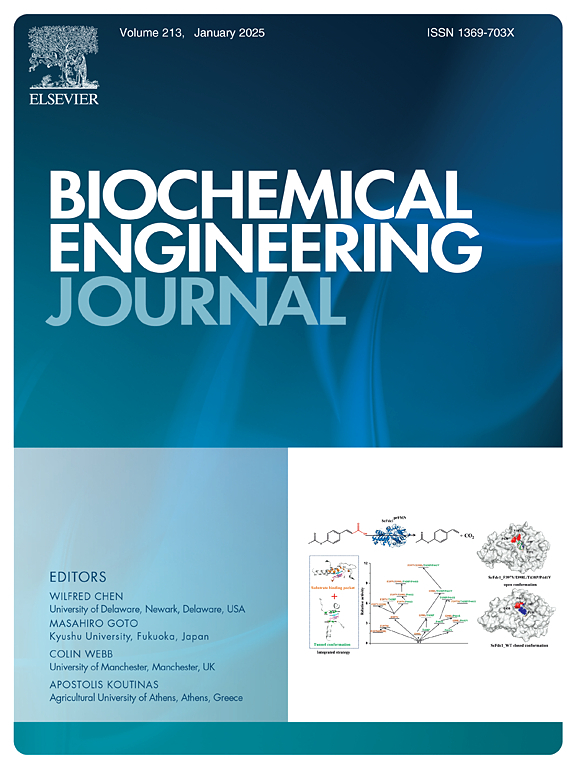Cell-free expression and biochemical characterization of polysaccharide-synthesizing glycosyltransferases
IF 3.7
3区 生物学
Q2 BIOTECHNOLOGY & APPLIED MICROBIOLOGY
引用次数: 0
Abstract
Polysaccharides like cellulose and hyaluronan are synthesized by membrane-bound family-2 glycosyltransferases (GTs) that play critical structural, metabolic, or functional roles in cells. Though GT-2 family has the maximum number of deposited gene sequences, the biochemistry is poorly understood due to enzyme production challenges. Here, we developed a cell-free expression (CFE) protocol to produce two GT-2 family representative cellulose synthase (PttCesA8 from Populus tremula x tremuloides) and hyaluronan synthase (SeHAS from Streptococcus equisimilis). The CFE products were obtained as reconstituted proteoliposomes directly at high yields and short processing times compared to other approaches. Enzyme expression was confirmed using SDS-PAGE and immunoblotting, while integration of GTs into lipid layers was observed using cryogenic electron microscopy. Both GTs were catalytically active with Michalis-Menten kinetic constants, Km for PttCesA8, was 295.8 µM, and SeHAS was 321.51 µM (toward UDP N-Acetyl Glucosamine) and 207.88 µM (toward UDP Glucuronic Acid), respectively, and with UDP inhibiting both GTs. Mutation of conserved residues in SeHAS also confirmed the importance of lysine-139, glutamine-248, and threonine-283 residues in hyaluronan biosynthesis. In summary, CFE methods enable expression of polysaccharide-synthesizing enzymes as proteoliposomes at high yields with relative ease for rapid biochemical and structural characterization studies.
多糖合成糖基转移酶的无细胞表达和生化鉴定
纤维素和透明质酸等多糖是由膜结合的 2 族糖基转移酶(GTs)合成的,它们在细胞中发挥着关键的结构、代谢或功能作用。虽然GT-2家族拥有最多的基因序列,但由于酶的生产面临挑战,人们对其生物化学还知之甚少。在此,我们开发了一种无细胞表达(CFE)方案,用于生产两种 GT-2 家族的代表性纤维素合成酶(来自杨树 x tremuloides 的 PttCesA8)和透明质酸合成酶(来自马氏链球菌的 SeHAS)。与其他方法相比,CFE 产物以重组蛋白脂质体的形式直接获得,产量高,处理时间短。使用 SDS-PAGE 和免疫印迹法确认了酶的表达,同时使用低温电子显微镜观察了 GTs 与脂质层的整合。两种 GT 都具有催化活性,其 Michalis-Menten 动力常数为:PttCesA8 的 Km 为 295.8 µM,SeHAS 为 321.51 µM(对 UDP N-Acetyl 葡萄糖胺)和 207.88 µM(对 UDP 葡萄糖酸),UDP 对两种 GT 都有抑制作用。对 SeHAS 中保守残基的突变也证实了赖氨酸-139、谷氨酰胺-248 和苏氨酸-283 残基在透明质酸生物合成中的重要性。总之,CFE 方法能以蛋白脂质体的形式高产表达多糖合成酶,而且相对容易进行快速生化和结构表征研究。
本文章由计算机程序翻译,如有差异,请以英文原文为准。
求助全文
约1分钟内获得全文
求助全文
来源期刊

Biochemical Engineering Journal
工程技术-工程:化工
CiteScore
7.10
自引率
5.10%
发文量
380
审稿时长
34 days
期刊介绍:
The Biochemical Engineering Journal aims to promote progress in the crucial chemical engineering aspects of the development of biological processes associated with everything from raw materials preparation to product recovery relevant to industries as diverse as medical/healthcare, industrial biotechnology, and environmental biotechnology.
The Journal welcomes full length original research papers, short communications, and review papers* in the following research fields:
Biocatalysis (enzyme or microbial) and biotransformations, including immobilized biocatalyst preparation and kinetics
Biosensors and Biodevices including biofabrication and novel fuel cell development
Bioseparations including scale-up and protein refolding/renaturation
Environmental Bioengineering including bioconversion, bioremediation, and microbial fuel cells
Bioreactor Systems including characterization, optimization and scale-up
Bioresources and Biorefinery Engineering including biomass conversion, biofuels, bioenergy, and optimization
Industrial Biotechnology including specialty chemicals, platform chemicals and neutraceuticals
Biomaterials and Tissue Engineering including bioartificial organs, cell encapsulation, and controlled release
Cell Culture Engineering (plant, animal or insect cells) including viral vectors, monoclonal antibodies, recombinant proteins, vaccines, and secondary metabolites
Cell Therapies and Stem Cells including pluripotent, mesenchymal and hematopoietic stem cells; immunotherapies; tissue-specific differentiation; and cryopreservation
Metabolic Engineering, Systems and Synthetic Biology including OMICS, bioinformatics, in silico biology, and metabolic flux analysis
Protein Engineering including enzyme engineering and directed evolution.
 求助内容:
求助内容: 应助结果提醒方式:
应助结果提醒方式:


